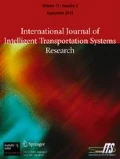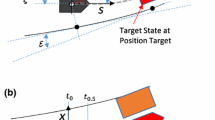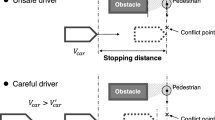Abstract
Recently, haptic guidance technologies have been proposed to enhance driving safety. This study concentrates on the influence of haptic guidance on driving behaviours estimated using mechanical arm admittance, while facing critical driving situation. We constructed an adaptable haptic guidance model, which can assist a driver to follow an ideal trajectory, with real-time steering feedback based on the monitoring of the lateral position and the yaw angle of the vehicle. In a driving simulator experiment, fourteen participants experienced seven designs of the haptic guidance model under three different amplitudes of steering perturbations. For high steering perturbation amplitudes, haptic guidance was effective in increasing arm stiffness leading to an improvement of the steering stability. For low steering perturbation amplitudes, arm stiffness was decreased by haptic guidance but the trajectory stability was enhanced.







Similar content being viewed by others
References
World Health Organization.: Global status report on road safety: time for action. World Health Organization, Geneva (2009)
National Highway Traffic Safety Administration: National motor vehicle crash causation survey: Report to Congress. National Highway Traffic Safety Administration Technical Report DOT HS, 811, 059 (2008)
Bar, F., Page, Y.: Les sorties de voies involontaires, Rueil-Malmaison, F: CEESAR, LAB (2002)
Emery, L., Srinivasan, G., Bezzina, D., et al.: Status report on USDOT project – an intelligent vehicle initiative road departure crash warning field operational test. Proceedings of the 19th International Technical Conference on the Enhanced Safety of Vehicles, Washington, DC, US DOT HS, 809, 825 (2005)
National Highway Traffic Safety Administration: The economic and societal impact of motor vehicle crashes, 2010 (revised). Ann. Emerg. Med. 66(2), 194–196 (2015)
Horberry, T., Anderson, J., Regan, M.A., Triggs, T.J., Brown, J.: Driver distraction: the effects of concurrent in-vehicle tasks, road environment complexity and age on driving performance. Accid. Anal. Prev. 38(1), 185–191 (2006). https://doi.org/10.1016/j.aap.2005.09.007
Tonnis, M., Lange, C., Klinker, G.: Visual longitudinal and lateral driving assistance in the head-up display of cars. In: 6th IEEE and ACM International Symposium on Mixed and Augmented Reality ISMAR 2007, pp. 91–94. IEEE, Nara (2007)
Singh, S.: Distracted driving and driver, roadway, and environmental factors. No. HS-811 380
Mulder, M., Abbink D.A., Boer, E.R.: The effect of haptic guidance on curve negotiation behavior of young, experienced drivers. In: IEEE International Conference on Systems, Man and Cybernetics SMC 2008, pp. 804–9. IEEE, Singapore (2008)
Mulder, M., Van Paassen, M.M., Abbink, D.A.: Haptic gas pedal feedback. Ergonomics. 51(11), 1710–1720 (2008). https://doi.org/10.1080/00140130802331583
Hwang, S., Ryu, J.H.: The haptic steering wheel: Vibro-tactile based navigation for the driving environment. In: 8th IEEE International Conference on Pervasive Computing and Communications Workshops (PERCOM Workshops), pp. 660–5. (2010)
Tsoi, K.K., Mulder, M., Abbink, D.A.: Balancing safety and support: changing lanes with a haptic lane-keeping support system. In: 2010 I.E. International Conference on Systems Man and Cybernetics (SMC), pp. 1236–43. (2010)
Abbink, D.A., Mulder, M., Boer, E.R.: Haptic shared control: smoothly shifting control authority? Cogn, Technol Work. 14(1), 19–28 (2012). https://doi.org/10.1007/s10111-011-0192-5
Nishimura, R., Wada, T., Sugiyama, S.: Haptic shared control in steering operation based on cooperative status between a driver and a driver assistance system. Journal of Human-Robot Interaction. 4(3), 19–37 (2015). https://doi.org/10.5898/4.3.Nishimura
Crespo, L.M., Reinkensmeyer, D.J.: Haptic guidance can enhance motor learning of a steering task. J. Mot. Behav. 40(6), 545–557 (2008). https://doi.org/10.3200/JMBR.40.6.545-557
Brandt, T., Sattel, T., Böhm, M.: Combining haptic human-machine interaction with predictive path planning for lane-keeping and collision avoidance systems. In: 2007 I.E. Intelligent Vehicles Symposium, pp. 582–587 (2007)
Cathers, I., O’Dwyer, N., Neilson, P.: Dependence of stretch reflexes on amplitude and bandwidth of stretch in human wrist muscle. Exp. Brain Res. 129(2), 278–287 (1999). https://doi.org/10.1007/s002210050898
Hasser, C.J., Cutkosky, M.R.: System identification of the human hand grasping a haptic knob. In: Symposium on haptic interfaces for virtual environment and teleoperator systems, pp. 180. IEEE, Orlando (2002)
Katzourakis, D.I., Abbink, D.A., Velenis, E., Holweg, E., Happee, R.: Driver's arms’ time-variant neuromuscular admittance during real car test-track driving. IEEE Trans. Instrum. Meas. 63(1), 221–230 (2014). https://doi.org/10.1109/TIM.2013.2277610
De Vlugt, E., Schouten, A.C., Van Der Helm, F.C.: Adaptation of reflexive feedback during arm posture to different environments. Biol. Cybern. 87(1), 10–26 (2002). https://doi.org/10.1007/s00422-002-0311-8
Abbink, D. A., Mulder, M.: Neuromuscular Analysis as a Guideline in Designing Shared Control. In: Advances in haptics. InTech (2010). https://doi.org/10.5772/8696
Güvenç, B.A., Bünte, T., Odenthal, D., Güvenç, L.: Robust two degree-of-freedom vehicle steering controller design. IEEE Trans. Control Syst. Technol. 12(4), 627–636 (2004). https://doi.org/10.1109/TCST.2004.824960
Najafi, B., Aminian, K., Paraschiv-Ionescu, A., Loew, F., Büla, C.J., Robert, P.: Ambulatory system for human motion analysis using a kinematic sensor: monitoring of daily physical activity in the elderly. IEEE Trans. Biomed. Eng. 50(6), 711–723 (2003). https://doi.org/10.1109/TBME.2003.812189
Jenkins, G., Watts D.: Spectral Analysis and its Applications, Holden-day, CA, 1968
Schouten, A.C., De Vlugt, E., van Hilten, J.B., Van Der Helm, F.C.: Quantifying proprioceptive reflexes during position control of the human arm. IEEE Trans. Biomed. Eng. 55(1), 311–321 (2008). https://doi.org/10.1109/TBME.2007.899298
Amberkar, S., Bolourchi, F., Demerly, J., Millsap, S.: A control system methodology for steer by wire systems. In: Steering and Suspension Technology Symposium, vol. 3. (2004)
Abbink, D.A., Mulder, M., Van Paassen, M.M.: Measurements of muscle use during steering wheel manipulation. In: 2011 I.E. International Conference on Systems, Man, and Cybernetics (SMC), pp. 1652–7. (2011)
McLean, J.R., Hoffmann, E.R.: Steering reversals as a measure of driver performance and steering task difficulty. Human Factors: J. Human Factors Ergon Soc. 17(3), 248–256 (1975). https://doi.org/10.1177/001872087501700304
Verster, J.C., Roth, T.: Standard operation procedures for conducting the on-the-road driving test, and measurement of the standard deviation of lateral position (SDLP). Int J Gen Med. 4, 359 (2012)
Author information
Authors and Affiliations
Corresponding author
Appendix
Appendix
In the following graphs, average of mechanical arm admittance coherence and phase are showed. Average values are presented since the importance of data lies in pattern presented. Indeed, square coherence is expected to be higher than 0.5 and phase should present a pattern similar to a second order mass spring damper system.
Square coherence and phase.
Rights and permissions
About this article
Cite this article
Joly, A., Shimono, K., Zheng, R. et al. Influence of Haptic Guidance on Arm Admittance of Driversunder Steering Perturbations. Int. J. ITS Res. 16, 187–200 (2018). https://doi.org/10.1007/s13177-017-0148-0
Received:
Revised:
Accepted:
Published:
Issue Date:
DOI: https://doi.org/10.1007/s13177-017-0148-0






